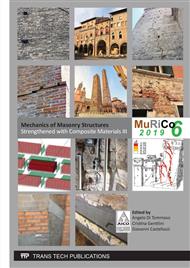[1]
P. B. Lourenço, R. de Borst, and J.G. Rots, A plane stress softening plasticity model for orthotropic materials, Int. J. Numer. Methods Eng. 40:21 (1997) 4033-4057.
DOI: 10.1002/(sici)1097-0207(19971115)40:21<4033::aid-nme248>3.0.co;2-0
Google Scholar
[2]
L. Berto, A. Saetta, R. Scotta, and R. Vitaliani, An orthotropic damage model for masonry-like structures, Int. J. Numer. Methods Eng. 2 (2002) 127-157.
DOI: 10.1002/nme.495
Google Scholar
[3]
L. Pelà, M. Cervera, and P. Roca, Continuum damage model for orthotropic materials: application to masonry, Comput. Methods Appl. Mech. Eng. 200:9-12 (2011) 917-930.
DOI: 10.1016/j.cma.2010.11.010
Google Scholar
[4]
G. Del Piero, Constitutive equation and compatibility of the external loads for linear elastic masonry-like materials, Meccanica (Milano) 24:3 (1989) 150-162.
DOI: 10.1007/bf01559418
Google Scholar
[5]
M. Cuomo and G. Ventura, A complementary energy formulation of no-tension masonry-like solids, Comput. Methods Appl. Mech. Eng. 189:1 (2000) 313-339.
DOI: 10.1016/s0045-7825(99)00298-4
Google Scholar
[6]
M. Angelillo, L. Cardamone, and A. Fortunato, A numerical model for masonry-like structures, J. Mech. Mater. Struct. 5:4 (2010) 583-615.
DOI: 10.2140/jomms.2010.5.583
Google Scholar
[7]
M. Bruggi, Finite element analysis of no-tension structures as a topology optimization problem, Struct. Multidiscip. Optim. 50:6 (2014) 957-973.
DOI: 10.1007/s00158-014-1093-z
Google Scholar
[8]
M. Bruggi and A. Taliercio, Analysis of no-tension structures under monotonic loading through an energy-based method, Comput. Struct. 159 (2015) 14-25.
DOI: 10.1016/j.compstruc.2015.07.002
Google Scholar
[9]
D. Briccola, M. Bruggi and A. Taliercio, Analysis of 3D no-tension masonry-like walls, J. Mech. Mater. Struct 13:5 (2018) 631-646.
DOI: 10.2140/jomms.2018.13.631
Google Scholar
[10]
D. Briccola and M. Bruggi, Analysis of 3D linear elastic masonry-like structures through the API of a finite element software, Adv. Eng. Softw. 133 (2019) 60-75.
DOI: 10.1016/j.advengsoft.2019.04.009
Google Scholar
[11]
P. Lenza, Modelli di comportamento e direttrici di restauro delle scale in murratura realizzate con voltine a sbalzo, Quaderni di Teoria e Tecnica delle Strutture, Univ. di Napoli, Istit. Di Tecnica delle Costruzioni, n.531.
DOI: 10.15651/978-88-748-8632-6
Google Scholar
[12]
G. Rondelet, Trattato Teorico e Pratico dell'arte di Edificare, 1883.
Google Scholar
[13]
M. Como, Cantilevered Stairways, in: Springer International Publishing AG 2017 (Eds.), Statics of Historic Masonry Constructions, Springer Series in Solid and Structural Mechanics., pp.417-435.
DOI: 10.1007/978-3-319-54738-1_8
Google Scholar
[14]
M. Bruggi, A. Taliercio, Optimal strengthening of no-tension structures with externally bonded reinforcing layers or ties, Struct. Multidiscip. Optim. 55:5 (2017) 1831-1846.
DOI: 10.1007/s00158-016-1625-9
Google Scholar


